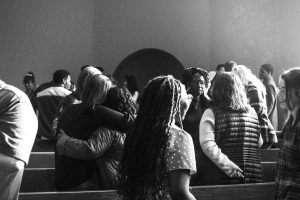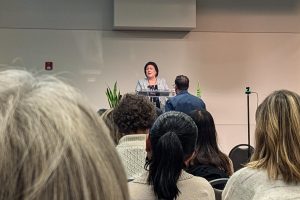Quarantine: the new college experience
Residents of Ashton hall recount their experiences in quarantine
October 14, 2020

The prospect of going back to school during a global pandemic comes with the risk of COVID-19 exposure. One case on a floor can put an entire community of people into quarantine. The first positive test result on the Seattle Pacific University campus came from a resident of Ashton Sixth East, sending the entire floor into a full fourteen day lockdown. The floor was finally set free on Friday, Oct. 2.
With the first few scares so early in the quarter, there wasn’t much of a grace period to figure out the most effective way to execute emergency quarantine protocols. Another floor in Ashton Hall, Ashton Fifth East, was quarantined for five days after a resident began showing symptoms of COVID-19. They ultimately tested negative, but the floor spent five days in quarantine while they awaited the test results.
“They didn’t even tell us when we were going into quarantine,” said first year Ashton Fifth East resident, Bridget Gehring. “Our RA knew first and warned us ahead of time to go to the store and get groceries and stuff because we might have to quarantine.”
Fellow first year and Ashton Fifth East resident, Colette Treadway, said that their Resident Advisor didn’t have much information about the quarantine. Treadway felt that her RA did a good job of communicating with them and being there for them, regardless, but wasn’t able to answer most of their questions because she didn’t know any more than they did.
“I feel like all the RAs should already know the COVID-19 procedures, so they can help students right away, right when quarantine hits,” Treadway said.
Gehring and Treadway said that one of the worst things about being in quarantine were the food options.
“When we would submit our meal form, you submitted what you wanted for dinner, which should have been a hot dinner but it was not. Then you got a cold breakfast and a cold lunch, but I would’ve liked to have the option to get a hot breakfast or a hot lunch,” said Gehring.
Treadway agreed that their hot dinner was always cold when it arrived, and was frustrated that they couldn’t have anyone send anything else up in the elevator for them to eat.
Chris Studtmann, the head chef at Gwinn, explained that it’s difficult to keep food temperatures up when it’s delivered in bulk. However, they’re working on getting better insulated packaging for the quarantine deliveries, as well as an app to help students place their orders.
“So, as opposed to being through a spreadsheet, we actually have an app that looks a lot like Grubhub, but it aligns 100% with our computer systems here on campus. The idea is that people can preorder for the next day, what they’re looking to have for breakfast and lunch, and then receive a hot dinner tonight, and drop-off. We have support from the mailroom who is already doing deliveries all around campus. They’re actually doing the physical deliveries. We’re training them on the food safety side of that,” said Studtmann.
Gehring and Treadway were fortunate enough to be released from eating quarantine food after five days, but Ashton Sixth East got the full two week experience.

“I didn’t think it would happen so soon,” said first year Cadence Moore. “I knew when I signed up to live in the dorms I agreed to be quarantined if we needed to, but I thought it probably wasn’t going to happen. Then right away it happened.”
Moore, a resident of Ashton Sixth East, was both shocked and stressed when she heard of her floor’s quarantine, especially because she would miss her first couple weeks of classes as a college student.
“It’s just what you have to do,” Moore said. “I was a little emotional. The first day when I read the email I was already starting to feel the cabin fever.”
Released just in time for midterms, Moore expressed relief at being able to attend her in-person and blended classes before testing began.
“Almost all of my classes are in-person at some time or another, so I had to email my professors and tell them I couldn’t come to class,” said Moore. “They were super understanding. I was able to get notes from people in class, and one professor let me join on Zoom.”
Another concern during their quarantine experience was social distancing in a traditional style dorm. With shared amenities, only four residents are allowed to use the bathroom at a time, and only one resident is allowed in the kitchen.
“We’re supposed to be social distancing, but we all have to go into the same room that has the microwave, so we’re all going in there and touching that stuff,” said Treadway.
While Ashton residents may share amenities, they do not share rooms this year, in order to limit the number of residents assigned to any one bathroom. Without a roommate, these Ashton residents were quarantined in almost total isolation.
“I talked to a lot of people in the bathroom because that’s like the only place you can,” said Moore. “You can stand inside your room with your mask on and the person across the way can do the same, so you can talk to people like that.”
With limited face-to-face interaction, Moore found other ways to keep busy when she wasn’t doing her course work.
“I’ve been writing letters to people,” Moore said. “I got caught up on that because I didn’t have anything else to do.”
Moore also occupied her time with online streaming services like Hulu and Disney Plus, although she said she was surprised at how often she was able to keep herself from getting bored.
“I don’t think it’s as bad as everyone thinks it is,” Moore said. “You just get used to it.”
According to Moore, the cabin fever wore off after a little while and didn’t return until her last couple of days in quarantine. She expressed that while it’s much better to be out and about than in quarantine, returning to normal after such a lack of human connection is a setback in itself.
“Don’t fall out of connection with people, because when I came back I felt like I missed out on two weeks of socialization,” said Moore. “Don’t miss out on that if you can because you never know when you’ll be quarantined.”


























































































